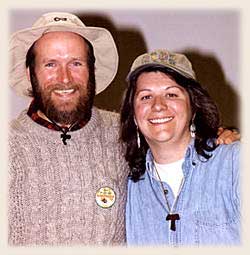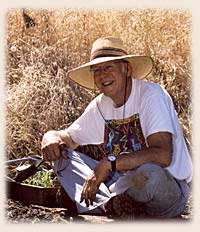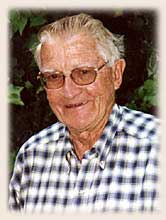|
SOIL, FOOD, &
PEOPLE CONFERENCE
March 27-29, 2000
GROW BIOINTENSIVE conference on the U.C. Davis campus
Home | Intro
| Presentations | Breakout
Sessions | Friends: Old
& New | Sponsors
GROW BIOINTENSIVE Friends Old and New
As stated elsewhere in this newsletter,
the conference was attended by wonderful people from all over the
world. We had hoped to talk with many of them, to get updates on
old friends and learn about the work of new acquaintances. However,
time constraints and a full schedule limited the number of contacts
that could be made.
The good news is that we now have names, addresses
and e-mail addresses from the participants list and hope to contact
many people over the next months to get their experiences for upcoming
newsletters.
Take a look below to find out what just a few
of our friends are up to:
Judy Sims
- elementary school GROW BIOINTENSIVE gardening program. |
|
|
|
 |
Larkin Stentz
- teaching gardening to children - GROW BIOINTENSIVE teacher
certification. |
 |
Boone Hallberg
- experimenting with crossing Opaque2 corn with Mexican varieties. |
 |
Judy Sims
Judy Sims from Santa Barbara attended the Ecology
Action Three-Day Workshop held there in 1998. She has been a teacher
for over 30 years and is involved in the school's gardening program.
At the Sunday evening meeting before the conference
she was talking so passionately about the importance of school gardens
that other people were encouraged to share their own experiences
gardening with children.
One of the Conference participants told Delaine
Eastin, California Superintendent of Public Education, about Judy's
work. Judy is currently a second grade school teacher who teaches
her curriculum through GROW BIOINTENSIVE food-raising including
a small farmers market and the preparation and cooking of the food
grown.
Delaine is working on a publication that helps
teachers infuse their teaching with concepts related to gardening,
nutrition and composting. She visited Judy on April 25 and afterward
noted Judy offers a model program of what the State is looking for
in a garden-based, nutrition-centered education that is cross-curricular.
top
Daniel & Amber Vallotton
Newsletter readers may remember this couple, who attended a Three-Day
Workshop and have spent some of their summers doing GROW BIOINTENSIVE
work in Mexico. Daniel also came to the first Teachers Workshop
at Ecology Action.
 The
Vallottons' big news is that they have finally found the land they
have been seeking for a long time. It is 610 acres in the Chihuahua
desert near Presidio, Texas, just across the Big Bend River from
Mexico and bordering on Big Bend State Park. Amber mentioned that
Gaspar Mayagoitia is only two hours away, in Chihuahua, Mexico. The
Vallottons' big news is that they have finally found the land they
have been seeking for a long time. It is 610 acres in the Chihuahua
desert near Presidio, Texas, just across the Big Bend River from
Mexico and bordering on Big Bend State Park. Amber mentioned that
Gaspar Mayagoitia is only two hours away, in Chihuahua, Mexico.
She said they had been unsure about the type of land they wanted.
They are drawn to green areas, but also love the desert. They had
even considered getting land in Mexico, but found out it is not
legal for foreigners to buy land near the border. When they saw
this land, they were sold.
Amber had many photos that were taken as they walked the land looking
for its corners. In some photos, it was possible to see the mountains
of Mexico in the distance. Others showed a substantial temporary
creek that runs after a rain. But basically, this is arid land that
experiences extremes of wind, heat and quick evaporation.
The Vallottons have wanted for a long time to develop an arid GROW
BIOINTENSIVE demonstration site. Amber said it will be a challenge
to work with the least amount of water and discover the best plants
to grow sustainably at the site. They think there is water, but
they will also develop catchment basins and will watch the vegetation
to figure out the best place to plant their garden. She mentioned
the possibility of developing a sustainable drip system, such as
one made from bamboo.
The biggest challenge they have now is to find funding so that
both of them will be able to work full time on the land and really
get the project underway. Currently, Amber teaches chemistry and
biology at Presidio High School. Daniel is still finishing a project
in Mexico under the auspices of New Mexico University.
top
Larkin Stentz
We wrote several articles in the newsletter quite
a few years ago about the GROW BIOINTENSIVE project Larkin and his
wife Michele were developing in Nayarit, Mexico. At the conference,
Larkin was reminiscing about his long-term relationship with Ecology
Action.
 He
said he moved to Palo Alto (a city south of San Francisco that was
the original site of Ecology Action) as a management consultant
and worked for Stanford and then Mt. Zion Hospital. He decided that
he did not want to have to work for a year. He spent some time at
Common Ground Garden Supply and Educational Center where he played
his flute. He played his flute at the Ecology Action's garden as
well. He
said he moved to Palo Alto (a city south of San Francisco that was
the original site of Ecology Action) as a management consultant
and worked for Stanford and then Mt. Zion Hospital. He decided that
he did not want to have to work for a year. He spent some time at
Common Ground Garden Supply and Educational Center where he played
his flute. He played his flute at the Ecology Action's garden as
well.
Larkin also helped double-dig beds for people
in the area and during this time he "got in touch with his
real muse." Larkin never went back to consulting, but was able
to support himself with his music. He played concerts and gave workshops
in 15 countries on 3 continents. The concerts were to help raise
environmental consciousness and to promote music more in harmony
with its surroundings.
Some time later, Larkin and Michele trained for
6 months to prepare them to undertake the Nayarit project. They
were there for 3 years, developing a demonstration garden and teaching
the method. They sold over 150 copies of the Spanish How
To Grow More Vegetables in the little town where they
lived. Their next move was to Port Angeles, Washington, where they
worked on various gardening projects.
Michele passed away a few years ago, but Larkin
has carried on with their work. He attended Ecology Action's Teacher
Certification Workshop in 1998 and today is teaching gardening to
children at an after-school program at the elementary school on
Long Beach Peninsula. He will be using this and other experience
to fulfill the research requirements to become a certified GROW
BIOINTENSIVE teacher at the basic level. At the conference, Larkin
opened several of the morning and afternoon sessions by playing
his flute.
top
Boone Hallberg
Boone Hallberg has spent most of his life in Mexico,
experimenting with crossing Opaque 2 corn with local varieties and
has been able to accomplish this with almost 50 varieties from different
villages. The resultant corn is high in lysine and tryptophane (amino
acids not generally found in corn, which make it a more complete
protein) and is highly productive, as well as resistant to pests
and disease.
 Asked
at the conference what he has been working on lately, he said he
has spent the last 9 years attending international meetings trying
to broaden people's minds about alternative types of farming techniques. Asked
at the conference what he has been working on lately, he said he
has spent the last 9 years attending international meetings trying
to broaden people's minds about alternative types of farming techniques.
With Boone was a young man, Francisco Ramos, who
is a student at the Instituto Technologico de Oaxaca. Francisco
has been surveying local indigenous farmers to find out why they
are still using the older, traditional methods of farming rather
than adopting the "newer" methods.
He said they have told him they are not interested
in making money, but rather in maintaining their self-sufficiency
and growing food for themselves. The families work together to produce
corn as part of their culture. They have been doing this for at
least 500 years without using chemicals.
Manor House Agricultural Centre in Kenya has recently
been experimenting with using some of Boone's Opaque 2 corn as an
alternative to the chemical-compatible corn that for many years
has been the only type available in Kenya.
top |